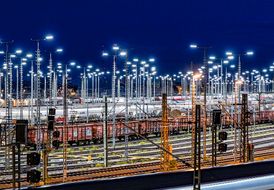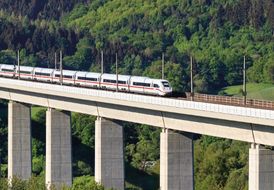Climate resilience
In the Global Climate Risk Index (Klima-Risiko-Index; KRI) published annually by German Watch, Germany ranked 18th worldwide. This relates to the period from 2000 to 2019, during which Germany was much more affected by extreme weather conditions than most other countries. As an infrastructure operator, our core business – the railway in Germany – is affected more than any other major company in Germany by the impacts of climate change. This was demonstrated by our first study commissioned from the Potsdam Institute for Climate Impact Research (PIK) in 2018.
We were again confronted with several extreme weather events in 2021. In addition to Storm Tristan in February, the floods in summer in North Rhine-Westphalia and Rhineland-Palatinate highlighted how heavily affected rail transport is by physical climate risks.
Analysis of climate scenarios
In 2021, we received the results of another study from the PIK, that we had commissioned. This time, the Institute examined climate changes between now and 2060 using two climate scenarios developed by the Intergovernmental Panel on Climate Change (best and worst case). The results showed significantly more heatwaves and fewer harsh winters along with increasing extreme weather conditions such as torrential rain and hail. For the first time, this study provides detailed forecasts on specific climate-related characteristics for 34 individual DB Group transport regions in Germany. These statements, which are based on climate science, form an important basis for the further strategic development of our climate-resilience management, the purpose of which is to further increase our resilience to extreme weather conditions.
Measures to adapt to climate change
In response to the expected future development of extreme weather conditions and the simultaneous expansion of rail transport in Germany, we are taking various measures to mitigate the consequences of climate change:
- Newly purchased trains at DB Long-Distance are designed to provide a stable indoor climate even in high temperatures, with the ICE 4 air-conditioning systems capable of coping with temperatures of up to 45°C, thus ensuring sufficient cooling for comfortable travel. We test the systems at least every six months. We spend tens of millions of euros per year in order to guarantee the stability of the air-conditioning systems in our long-distance trains.
- At DB Netz AG, the natural hazard management-department deals with extreme weather events and adapting to climate impacts in order to reduce the negative effects on the rail infrastructure to a minimum. Natural hazard management has identified and integrated three core tasks, namely winter management, vegetation management for storm protection, and heat prevention. Timely inspection of all 6,300 heating systems for the 49,000 switches with switch heaters and the early provision of removal and safety personnel are important components of the winter strategy. In response to Storm Tristan in February 2021, additional potential for improvement during extreme winter events was identified.
- In order to facilitate proactive heat prevention, new air-conditioning systems will be installed to protect the heat-sensitive command and control technology, temperature sensors will be fitted at critical points, and new construction components and buildings will be designed to withstand higher temperatures. We are also actively working on the existing network and are additionally deploying new methods, materials and knowledge – such as phase-change materials or thermally optimized coatings developed in space technology research.
- Another focus is on storm protection and vegetation management on the tracks. An average of€ 150 million per year has been made available for these tasks from 2021 to 2025. Vegetation management is constantly being improved.



